Trade-Off between COVID-19 Pandemic Prevention and Control and Economic Stimulus
Abstract
1. Introduction
2. Literature Review
2.1. Economic Impact and Intervention Policies
2.2. Relationship between Epidemic Containment and Economic Development
3. Epidemic Dynamic Model
4. Optimal Control Problem
4.1. System Dynamic Model
4.2. Optimal Control Problem
5. Model Solution of Optimal Control Problem
5.1. Solution of Static Strategy
5.2. Solution of the Dynamic Strategy
5.2.1. Dynamic Programming
5.2.2. Effects on Optimal Strategies
6. Numerical Simulation and Results Analysis
6.1. Validation of Epidemic Dynamic Model
6.2. Results of Static Strategy
6.2.1. Optimal Solution of Static Strategy
6.2.2. Low Strength of Epidemic Prevention and Control
6.2.3. Low Strength of Economic Stimulus Measures
6.3. Results of Dynamic Strategy
7. Sensitivity Analysis of Model Parameters
8. Conclusions
- (1)
- The SIR model can be incorporated into the optimal control problem to formulate a trade-off between the epidemic prevention and control and economic stimulus measures. Such research framework and methodology can also be applied to other epidemics.
- (2)
- Solving the dynamic strategy requires accurate information with regard to the epidemic’s duration. The static strategy operates independent of this information, with the assumption of consistent control variables. Thus, the optimal solutions of the static and dynamic strategies are a pair of points and trajectories of control variables, respectively. Additionally, a comparison of the two strategies reveals that the optimal total social and economic benefit in the dynamic strategy is slightly greater than that of the static strategy.
- (3)
- For the static strategy, when the government chooses a low strength of pandemic prevention and control measures (for example, 3% anti-epidemic strength), then the optimal strength of the economic stimulus is 50%. In addition, the total benefit would be significantly lowered (compared to the optimal solution) over the whole optional range. If low-strength economic stimulus measures are chosen (for example, 3% economic stimulus strength), then the optimal anti-epidemic strength is 37%. If the strength of government anti-epidemic measures exceeds the optimal value, the total social and economic benefit diminishes, and a negative value is produced. The result is severe damage to both social and economic activity and public health.
- (4)
- The solution of the dynamic strategy indicates that the government should sustain a specific strength of pandemic prevention and control measures from the beginning and then gradually improve those measures until they attain the peak value. However, an almost constant strength of the economic stimulus should initially be maintained. The peak values of both control variables are located after the summit of the infections, or the middle-to-late stage of the duration. After that, the government should properly reduce the investments in both types of decision-making behaviors.
- (5)
- The sensitivity analysis of the overall parameters in the objective function indicates that in the static strategy, the optimal strengths of both governmental decision behaviors present a small fluctuation around the fixed point. For the dynamic strategy, the peak values of the trajectories of both control variables move with the variable parameters. This shows the time when the maximum strength is implemented, but the tendencies of the curves are almost invariable. Moreover, the influence of individual parameters on the socio-economic benefit is examined, and the results demonstrate their different sensitivities.
9. Limitations
Author Contributions
Funding
Institutional Review Board Statement
Informed Consent Statement
Data Availability Statement
Acknowledgments
Conflicts of Interest
References
- Office Website of World Health Organization. Available online: https://www.who.int/emergencies/diseases/novel-coronavirus-2019 (accessed on 16 October 2022).
- International Monetary Fund. World Economic Outlook: October 2021; International Monetary Fund: Washington, DC, USA, 2021. [Google Scholar]
- Zhao, Y.; Huang, J.; Zhang, L.; Lian, X.; Wang, D. Is omicron variant of SARS-CoV-2 coming to an end? Innovation 2022, 3, 100240. [Google Scholar] [CrossRef] [PubMed]
- Anderson, R.M.; Heesterbeek, H.; Klinkenberg, D.; Hollingsworth, T.D. How will country-based mitigation measures influence the course of the COVID-19 epidemic? Lancet 2020, 395, 931–934. [Google Scholar] [CrossRef]
- Kraemer, M.U.G.; Yang, C.H.; Gutierrez, B.; Wu, C.-H.; Klein, B.; Pigott, D.M.; du Plessis, L.; Faria, N.R.; Li, R.; Hanage, W.P.; et al. The effect of human mobility and control measures on the COVID-19 epidemic in China. Science 2020, 368, 493–497. [Google Scholar] [CrossRef] [PubMed]
- Bonaccorsi, G.; Pierri, F.; Cinelli, M.; Flori, A.; Galeazzi, A.; Procelli, F.; Schmidt, A.L.; Valensise, C.M.; Scala, A.; Quattrociocchi, W.; et al. Economic and social consequences of human mobility restrictions under COVID-19. Proc. Natl. Acad. Sci. USA 2020, 117, 15530–15535. [Google Scholar] [CrossRef] [PubMed]
- Chen, J.-M.; Chen, Y.-Q. China can prepare to end its zero-COVID policy. Nat. Med. 2022, 28, 1104–1105. [Google Scholar] [CrossRef] [PubMed]
- Leng, A.; Maitland, E.; Wang, S.; Nicholas, S.; Liu, R.; Wang, J. Individual preferences for COVID-19 vaccination in China. Vaccine 2021, 39, 247–254. [Google Scholar] [CrossRef] [PubMed]
- Jinjarak, Y.; Ahmed, R.; Nair-Desai, S.; Xin, W.; Aizenman, J. Pandemic shocks and fiscal-monetary policies in the Eurozone: COVID-19 dominance during January–June 2020. Oxf. Econ. Pap. 2021, 73, 1557–1580. [Google Scholar] [CrossRef]
- Alberola, E.; Arslan, Y.; Cheng, G.; Moessner, R. Fiscal response to the COVID-19 crisis in advanced and emerging market economies. Pac. Econ. Rev. 2021, 26, 459–468. [Google Scholar] [CrossRef]
- Feyisa, H.L. The World Economy at COVID-19 quarantine: Contemporary review. Int. J. Econ. Financ. Manag. Sci. 2020, 8, 63–74. [Google Scholar]
- Pan, W.; Huang, G.; Shi, Y.; Hu, C.; Dai, W.-Q.; Pan, W.; Rongsheng, H. COVID-19: Short-term influence on China’s economy considering different scenarios. Glob. Chall. 2021, 5, 2000090. [Google Scholar] [CrossRef]
- Liu, W.; Yue, X.G.; Tchounwou, P.B. Response to the COVID-19 epidemic: The Chinese experience and implications for other countries. Int. J. Environ. Res. Public Health 2020, 17, 2304. [Google Scholar] [CrossRef] [PubMed]
- Xiao, Y.; Torok, M.E. Taking the right measures to control COVID-19. Lancet Infect. Dis. 2020, 20, 523–524. [Google Scholar] [CrossRef]
- Blustein, D.L.; Duffy, R.; Ferreira, J.A.; Cohen-Scali, V.; Cinamon, R.G.; Allan, B.A. Unemployment in the time of COVID-19: A research agenda. J. Vocat. Behav. 2020, 119, 103436. [Google Scholar] [CrossRef] [PubMed]
- Carlsson-Szlezak, P.; Reeves, M.; Swartz, P. Understanding the economic shock of coronavirus. Harv. Bus. Rev. 2020, 27, 4–5. [Google Scholar]
- Carlsson-Szlezak, P.; Reeves, M.; Swartz, P. What coronavirus could mean for the global economy. Harv. Bus. Rev. 2020, 3, 1–10. [Google Scholar]
- Jordà, Ò.; Singh, S.R.; Taylor, A.M. Longer-run economic consequences of pandemics. Rev. Econ. Stat. 2022, 104, 166–175. [Google Scholar] [CrossRef]
- Brodeur, A.; Gray, D.; Islam, A.; Bhuiyan, S. A literature review of the economics of COVID-19. J. Econ. Surv. 2021, 35, 1007–1044. [Google Scholar] [CrossRef]
- Cutler, D.M.; Summers, L.H. The COVID-19 pandemic and the $16 trillion virus. JAMA 2020, 324, 1495–1496. [Google Scholar] [CrossRef]
- Tan, L.; Wu, X.; Guo, J.; Santibanez-Gonzalez, E.D.R. Assessing the impacts of COVID-19 on the industrial sectors and economy of China. Risk Anal. 2022, 42, 21–39. [Google Scholar] [CrossRef]
- Fadinger, H.; Schymik, J. The costs and benefits of home office during the COVID-19 pandemic: Evidence from infections and an input-output model for Germany. COVID Econ. Vetted Real-Time Pap. 2020, 9, 107–134. [Google Scholar]
- Pollitt, H.; Lewney, R.; Kiss-Dobronyi, B.; Lin, X. Modelling the economic effects of COVID-19 and possible green recovery plans: A post-Keynesian approach. Clim. Policy 2021, 21, 1257–1271. [Google Scholar] [CrossRef]
- Makin, A.J.; Layton, A. The global fiscal response to COVID-19: Risks and repercussions. Econ. Anal. Policy 2021, 69, 340–349. [Google Scholar] [CrossRef]
- Petrović, P.; Arsić, M.; Nojković, A. Increasing public investment can be an effective policy in bad times: Evidence from emerging EU economies. Econ. Model. 2021, 94, 580–597. [Google Scholar] [CrossRef]
- Sansa, N.A. The impact of the COVID-19 on the financial markets: Evidence from China and USA. Electron. Res. J. Soc. Sci. Humanit. 2020, 2, 29–39. [Google Scholar]
- Liu, X.; Liu, Y.; Yan, Y. China macroeconomic report 2020: China’s macroeconomy is on the rebound under the impact of COVID-19. Econ. Political Stud. 2020, 8, 395–435. [Google Scholar] [CrossRef]
- Gong, B.; Zhang, S.; Yuan, L.; Chen, K.Z. A balance act: Minimizing economic loss while controlling novel coronavirus pneumonia. J. Chin. Gov. 2020, 5, 249–268. [Google Scholar] [CrossRef]
- Lin, J. Relationship between epidemic prevention and control and economic development in China. Acad. J. Humanit. Soc. Sci. 2022, 5, 82–88. [Google Scholar]
- Eichenbaum, M.S.; Rebelo, S.; Trabandt, M. The macroeconomics of epidemics. Rev. Financ. Stud. 2021, 34, 5149–5187. [Google Scholar] [CrossRef]
- Yin, Z.; Chen, X.; Wang, Z.; Xiang, L. Government epidemic prevention and economic growth path under public health emergency: Theoretical model and simulation analysis. Front. Public Health 2021, 9, 748041. [Google Scholar] [CrossRef]
- Xiang, L.; Tang, M.; Yin, Z.; Zhang, M.; Lu, S. The COVID-19 pandemic and economic growth: Theory and simulation. Front. Public Health 2021, 9, 741525. [Google Scholar] [CrossRef]
- Kermack, W.O.; McKendrick, A.G. A contribution to the mathematical theory of epidemics. Proc. R. Soc. Lond. Ser. A Contain. Pap. A Math. Phys. Character 1927, 115, 700–721. [Google Scholar]
- Wacker, B.; Schlüter, J. Time-continuous and time-discrete SIR models revisited: Theory and applications. Adv. Differ. Equ. 2020, 1, 556. [Google Scholar] [CrossRef] [PubMed]
- Paul, S.; Mahata, A.; Ghosh, U.; Roy, B. Study of SEIR epidemic model and scenario analysis of COVID-19 pandemic. Ecol. Genet. Genom. 2021, 19, 100087. [Google Scholar] [CrossRef] [PubMed]
- Epstein, J.M. Modelling to contain pandemics. Nature 2009, 460, 687. [Google Scholar] [CrossRef] [PubMed]
- Gnanvi, J.E.; Salako, K.V.; Kotanmi, G.B.; Kakaï, R.G. On the reliability of predictions on COVID-19 dynamics: A systematic and critical review of modelling techniques. Infect. Dis. Model. 2021, 6, 258–272. [Google Scholar] [CrossRef]
- Hu, Z.; Ge, Q.; Jin, L.; Xiong, M. Artificial intelligence forecasting of COVID-19 in China. arXiv 2020, arXiv:2002.07112. [Google Scholar] [CrossRef]
- Yi, D.; Li, Q.; Wang, N. Numerical Analysis, 5th ed.; Tsinghua University Press: Beijing, China, 2008. [Google Scholar]
- Kamien, M.I.; Schwartz, N.L. Dynamic Optimization: The Calculus of Variations and Optimal Control in Economics & Management; Courier Corporation: North Chelmsford, MA, USA, 1998. [Google Scholar]
- Office Website of Health Commission of Hubei Province. Available online: http://wjw.hubei.gov.cn/bmdt/ztzl/fkxxgzbdgrfyyq/xxfb/ (accessed on 30 December 2021).
- Available online: https://ncov.dxy.cn/ncovh5/view/pneumonia?share=0&dxa_adplatform=m.dxy.com (accessed on 15 January 2022).
- Application of Dingxiangyuan in the Android System. Available online: https://www.dxy.cn/pages/iconlink.html (accessed on 15 January 2022).
- Sheng, H.; Wu, L.; Xiao, C. Modeling analysis and prediction on NCP epidemic transmission. J. Syst. Simul. 2020, 32, 759–765. [Google Scholar]
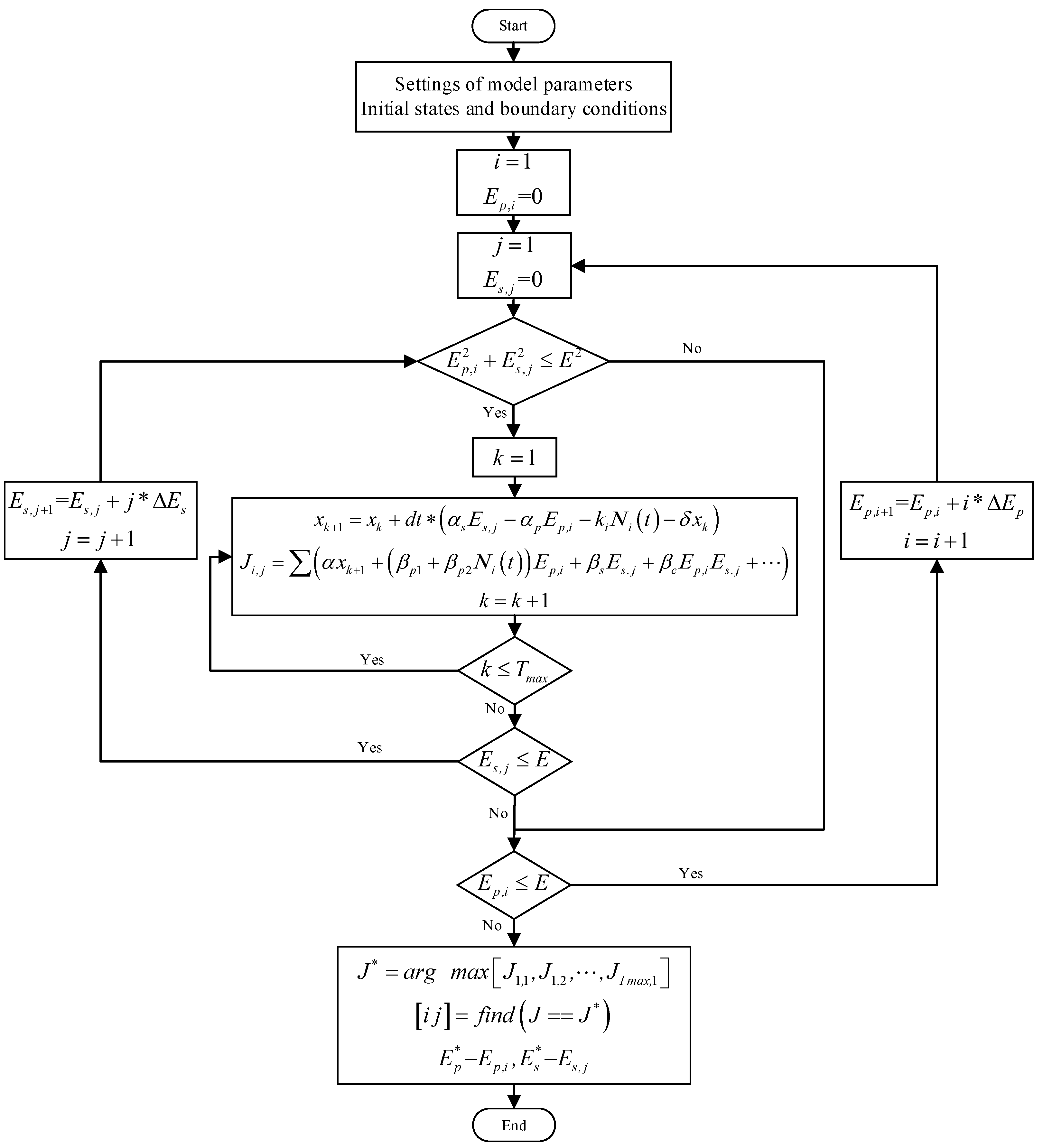
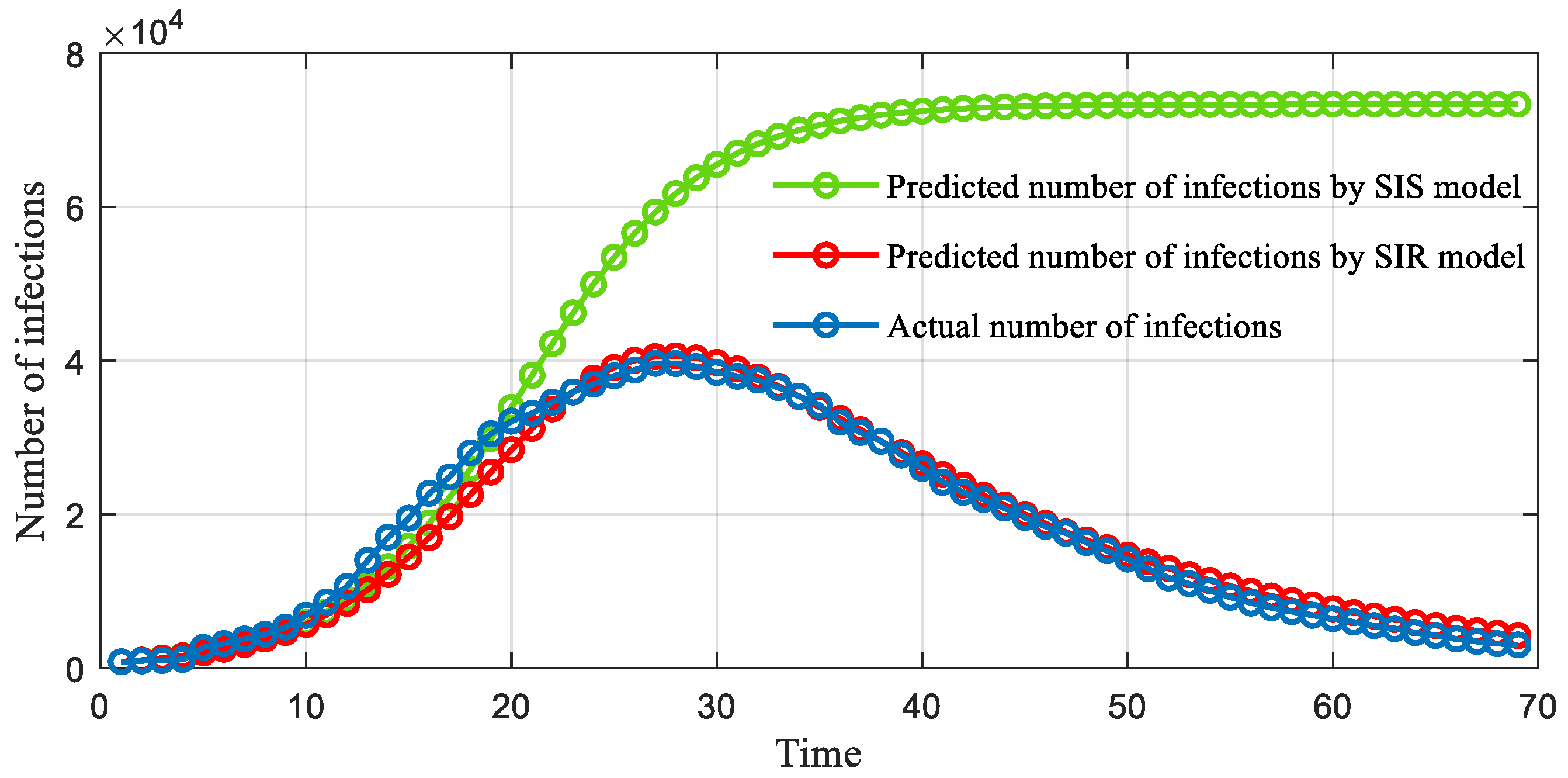
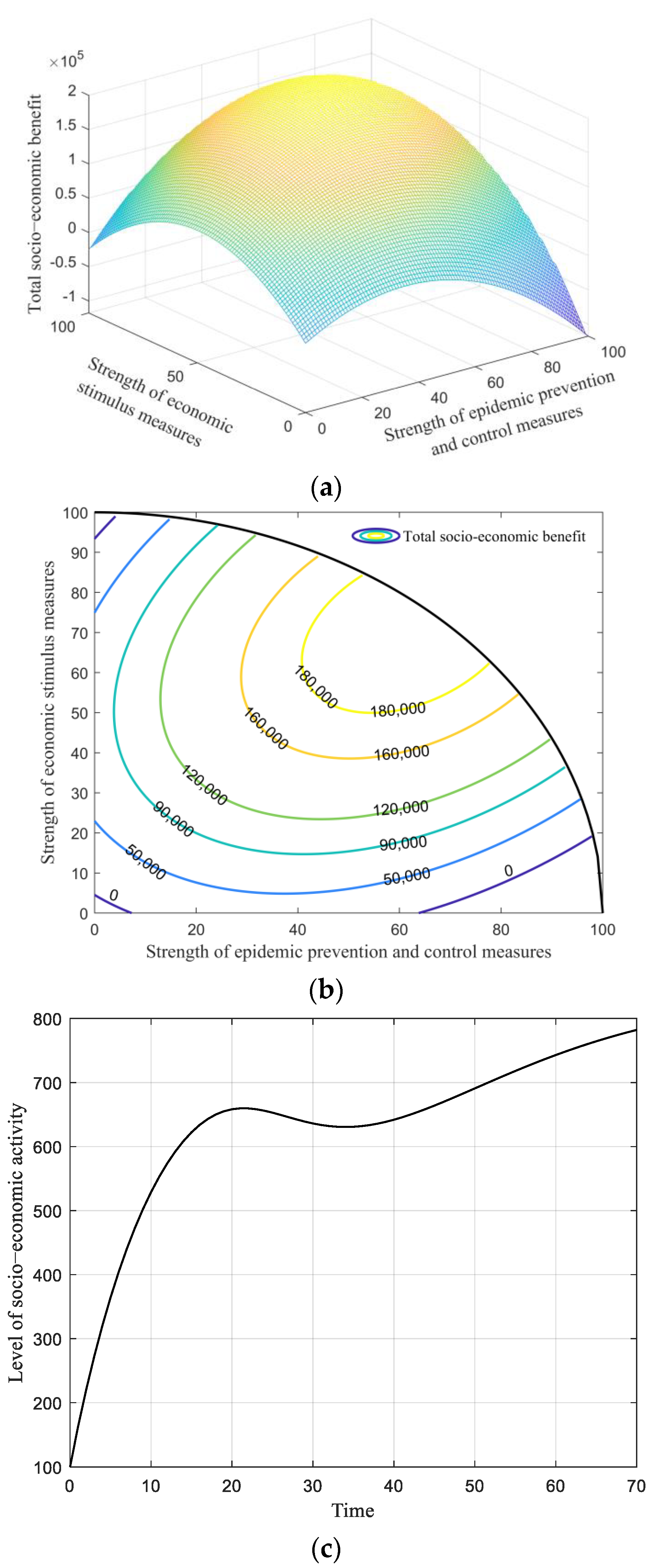


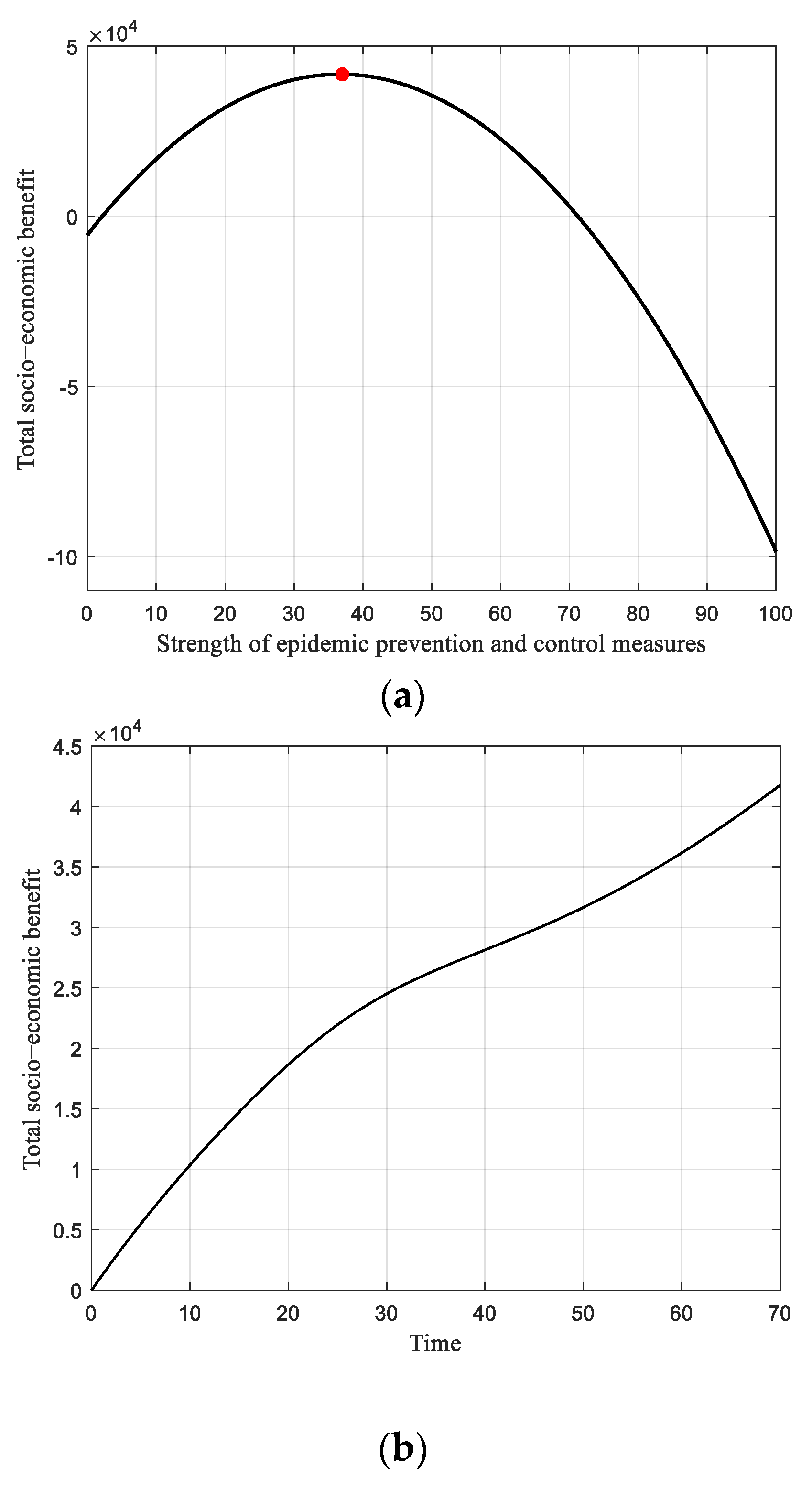

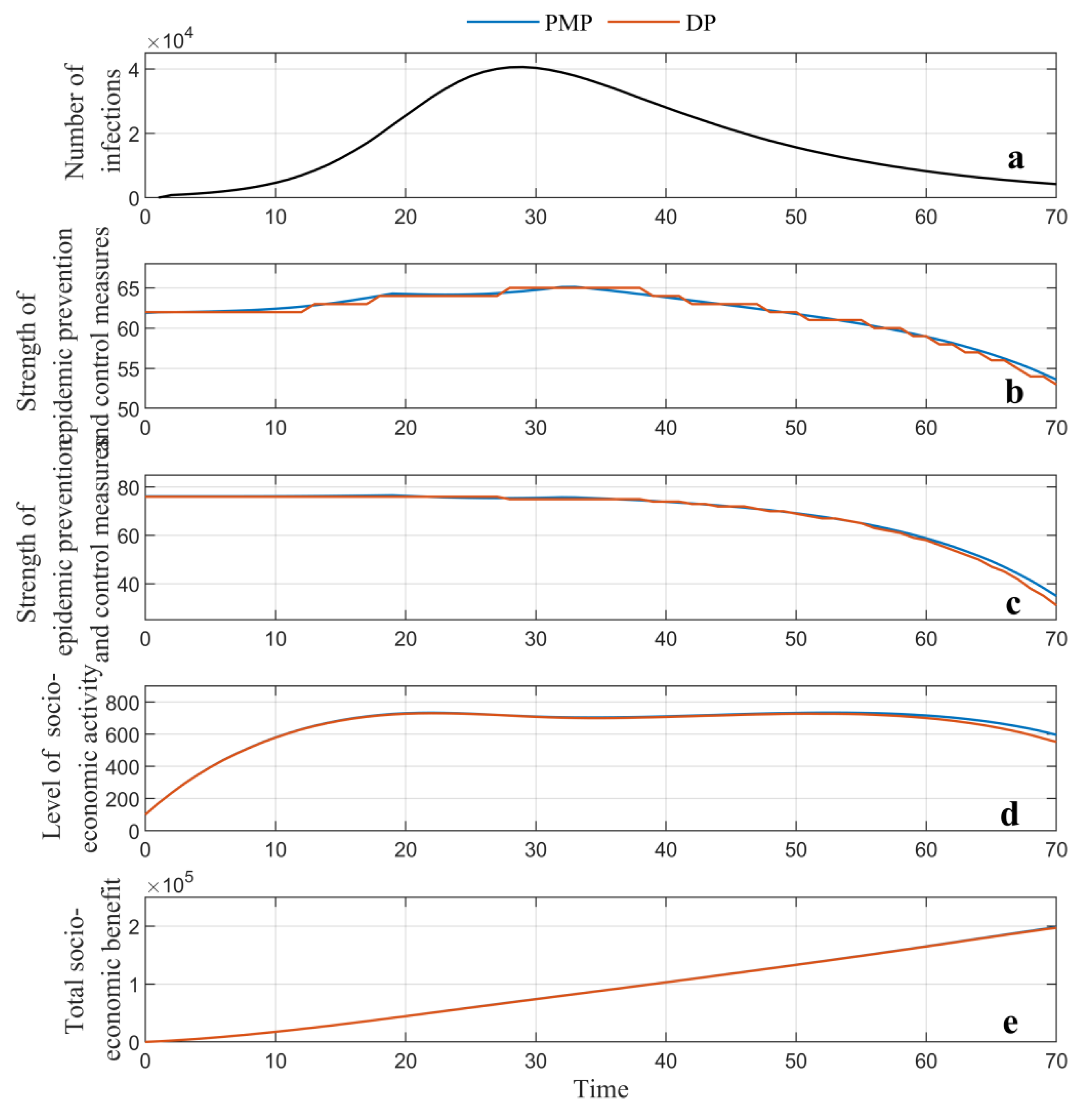
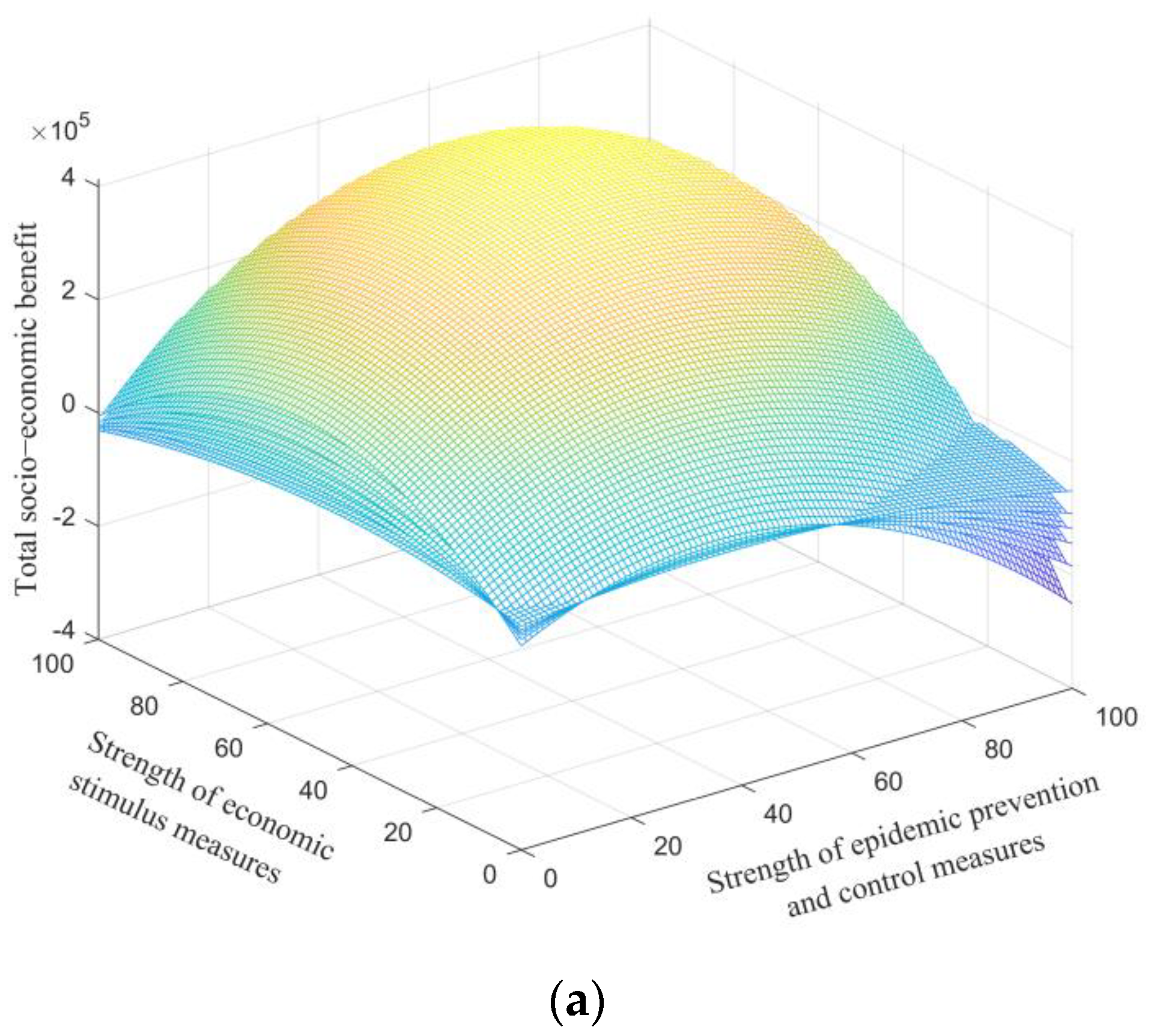

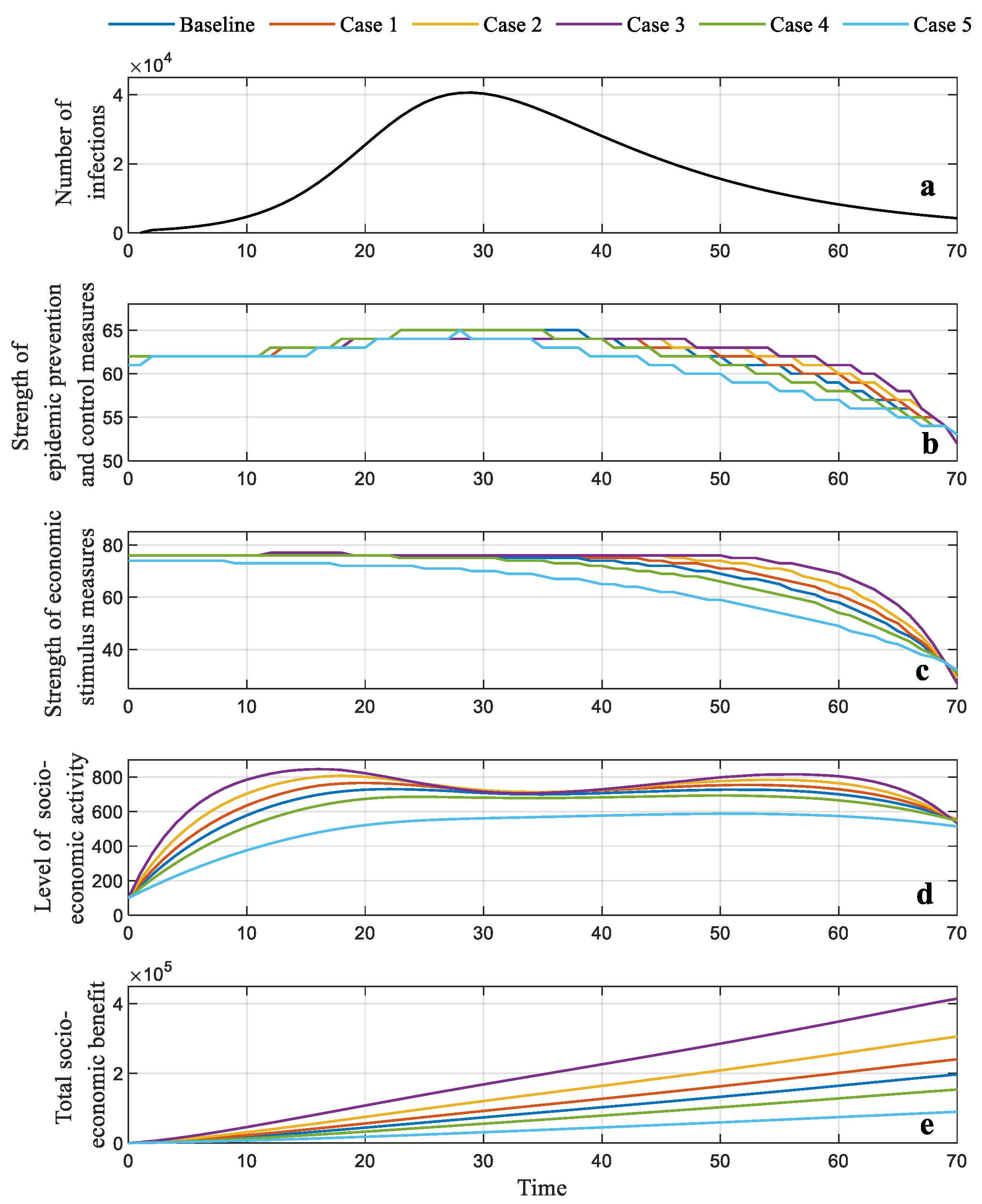
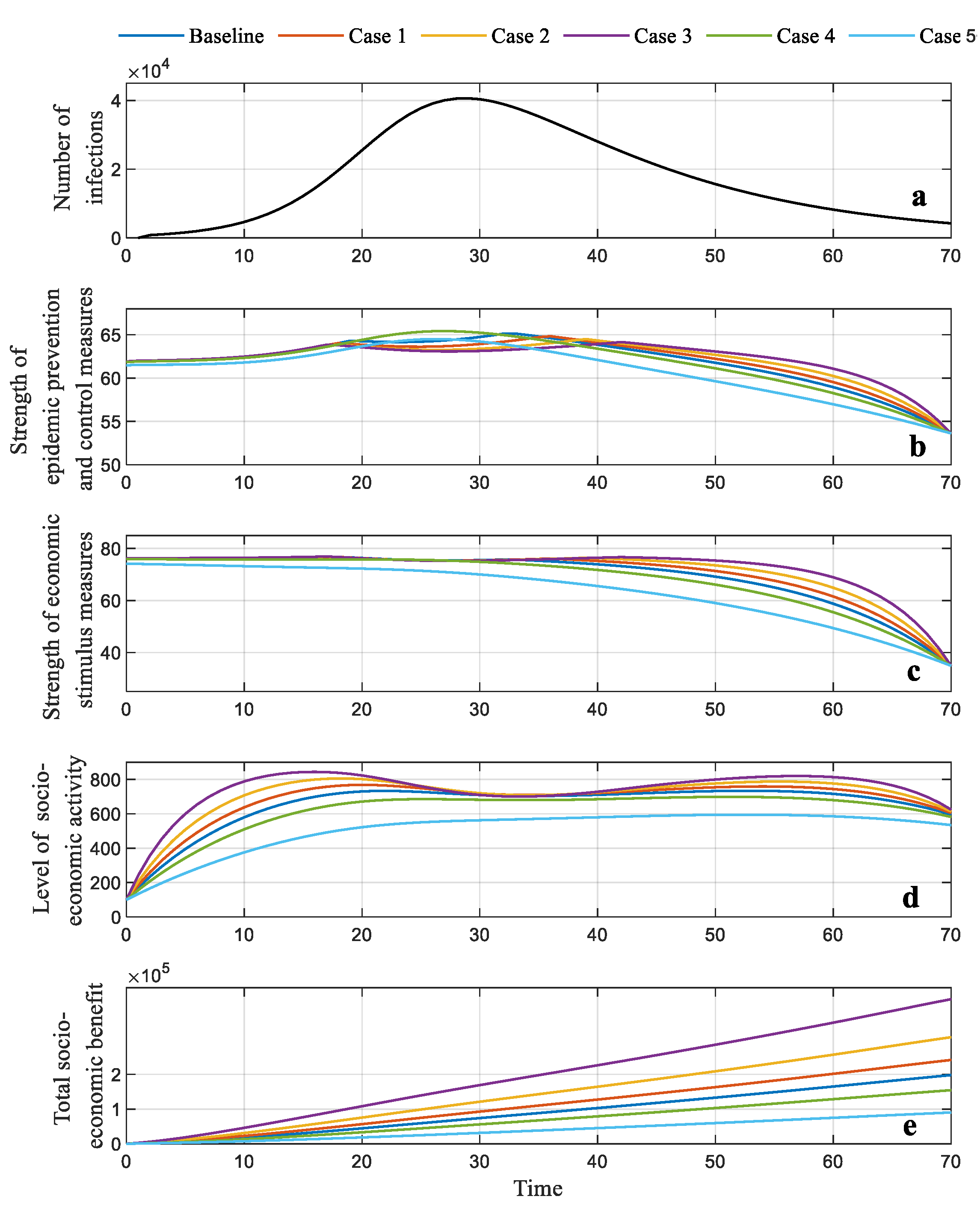
| Symbol | ||||||||||
|---|---|---|---|---|---|---|---|---|---|---|
| Value | 2.6 × 10−8 | 0.071 | 5 × 10−4 | 3 | 1.0 | 1.1 | 18 | 40 | 8.5 × 10−5 | 1.2 |
| Symbol | S | I | R | |||||||
| Value | 0.2 | 0.085 | 0.38 | 9 × 104 | 0 | 0 | 100 | 70 | 10 | 100 |
| Case | Parameters Variation | Static Strategy | Dynamic Strategy | Comparison of Two Strategies | |
|---|---|---|---|---|---|
| Percentage Increment of Total Benefit (%) | Optimal Strengths of Decision Behaviors (Ep, Es) | Percentage Increment of Total Benefit (%) | Percentage Increment (%) | ||
| Baseline | - | - | 62, 70 | - | - |
| Case 1 | 20% increment | 22.3 | 63, 72 | 22.0 | 2.81 |
| Case 2 | 50% increment | 56.0 | 63, 73 | 55.2 | 0.95 |
| Case 3 | 100% increment | 112.2 | 63, 74 | 110.4 | −10.19 |
| Case 4 | 20% reduction | −22.2 | 62, 69 | −22.0 | −7.97 |
| Case 5 | 50% reduction | −54.7 | 61, 64 | −54.4 | −35.02 |
| Parameter | Static Strategy | Dynamic Strategy | ||
|---|---|---|---|---|
| 30% Increment in Individual Parameter | 30% Reduction in Individual Parameter | |||
| 22.47 | 22.44 | −18.71 | −19.16 | |
| 29.31 | 28.29 | −23.99 | −23.63 | |
| 1.03 | 1.04 | −1.02 | −1.02 | |
| 14.28 | 13.84 | −13.17 | −12.98 | |
| −21.98 | −22.02 | 36.03 | 34.53 | |
| −15.62 | −15.42 | 26.37 | 25.22 | |
| 19.98 | 18.88 | −15.40 | −15.24 | |
Publisher’s Note: MDPI stays neutral with regard to jurisdictional claims in published maps and institutional affiliations. |
© 2022 by the authors. Licensee MDPI, Basel, Switzerland. This article is an open access article distributed under the terms and conditions of the Creative Commons Attribution (CC BY) license (https://creativecommons.org/licenses/by/4.0/).
Share and Cite
Liu, F.; Ma, Z.; Wang, Z.; Xie, S. Trade-Off between COVID-19 Pandemic Prevention and Control and Economic Stimulus. Int. J. Environ. Res. Public Health 2022, 19, 13956. https://doi.org/10.3390/ijerph192113956
Liu F, Ma Z, Wang Z, Xie S. Trade-Off between COVID-19 Pandemic Prevention and Control and Economic Stimulus. International Journal of Environmental Research and Public Health. 2022; 19(21):13956. https://doi.org/10.3390/ijerph192113956
Chicago/Turabian StyleLiu, Fangfang, Zheng Ma, Ziqing Wang, and Shaobo Xie. 2022. "Trade-Off between COVID-19 Pandemic Prevention and Control and Economic Stimulus" International Journal of Environmental Research and Public Health 19, no. 21: 13956. https://doi.org/10.3390/ijerph192113956
APA StyleLiu, F., Ma, Z., Wang, Z., & Xie, S. (2022). Trade-Off between COVID-19 Pandemic Prevention and Control and Economic Stimulus. International Journal of Environmental Research and Public Health, 19(21), 13956. https://doi.org/10.3390/ijerph192113956





